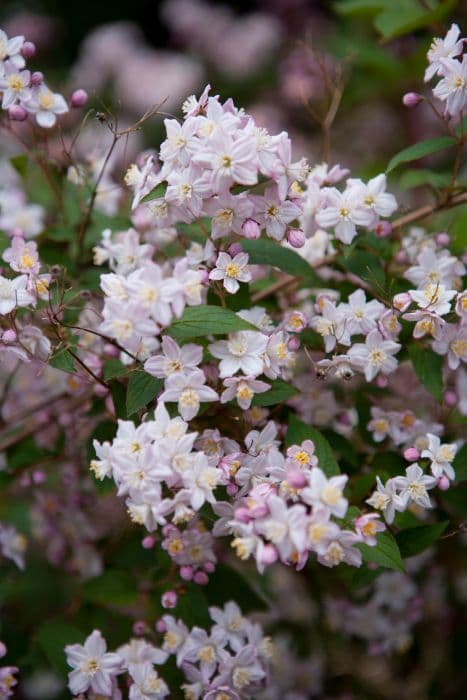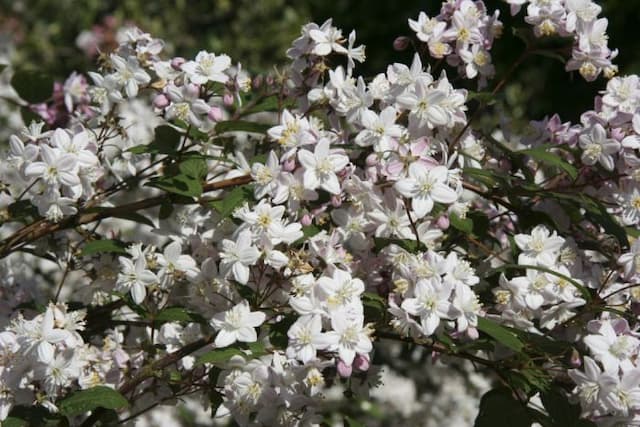Climbing Hydrangea Pileostegia viburnoides

ABOUT
The plant, commonly known as climbing hydrangea, is an evergreen climber with a woody stem. Its leaves are leathery to the touch and shaped like broad elongated ovals, coming to a gentle point at their tips. Their edges are slightly serrated, and they boast a deep, glossy green hue. Throughout the warmer months, the climbing hydrangea produces clusters of small, white, and fragrant flowers that form dense, flat-topped heads. These blossoms are quite appealing to pollinators, such as bees and butterflies. The flowers give way to dry, brown fruit in the fall which may persist through the winter. In its overall aspect, climbing hydrangea is lush and can add a verdant, cascading aesthetic to garden walls or trellises where it often finds support to grow.
About this plant
 Names
NamesFamily
Hydrangeaceae.
Synonyms
Climbing Hydrangea, Evergreen Climbing Hydrangea.
Common names
Pileostegia viburnoides
 Toxicity
ToxicityTo humans
The plant commonly known as climbing hydrangea (Pileostegia viburnoides) is not widely reported to be toxic to humans. There is no significant evidence of poisoning or harmful effects from ingesting parts of this plant. However, it's generally advisable to refrain from eating ornamental plants due to the potential for idiosyncratic reactions or the possibility of misidentification with harmful species. Always seek professional medical advice if ingestion occurs and any adverse symptoms are experienced.
To pets
Climbing hydrangea (Pileostegia viburnoides) is not widely recognized as toxic to pets. There is a lack of substantive information regarding the toxicity of this particular plant to animals. As with humans, it is recommended to prevent pets from ingesting ornamental plants, since they might have unexpected reactions or the plant could be misidentified as a toxic species. If a pet does ingest climbing hydrangea and shows signs of distress, contacting a veterinarian is the prudent course of action.
 Characteristics
CharacteristicsLife cycle
Perennials
Foliage type
Evergreen
Color of leaves
Green
Flower color
White
Height
10-15 feet (3-4.5 meters)
Spread
6-8 feet (1.8-2.4 meters)
Plant type
Climber
Hardiness zones
8
Native area
China
Benefits
 General Benefits
General Benefits- Ornamental value: Its evergreen foliage and clusters of creamy white flowers add aesthetic appeal to gardens and landscapes.
- Low maintenance: Once established, Pileostegia viburnoides, also known as climbing hydrangea, requires minimal care and can thrive with basic gardening practices.
- Shade tolerance: It is well-suited for planting in shaded areas where many other plants struggle to grow.
- Erosion control: Its climbing and spreading habit can help stabilize soil on slopes and banks, reducing erosion.
- Wildlife habitat: The flowers provide nectar for pollinators such as bees and butterflies, while the dense foliage offers shelter for birds and small mammals.
- Versatility: It can be used as ground cover, for covering walls, fences, and trellises, or even as a specimen plant in a garden setting.
 Medical Properties
Medical PropertiesThis plant is not used for medical purposes.
 Air-purifying Qualities
Air-purifying QualitiesThis plant is not specifically known for air purifying qualities.
 Other Uses
Other Uses- Climbing Cover: Pileostegia viburnoides can be used to cover unsightly structures like walls or fences as it is an evergreen climber that provides year-round greenery.
- Noise Reduction: When planted densely, the plant can help to absorb sound, making it useful for planting near roads or in urban areas where noise pollution is an issue.
- Wildlife Habitat: This plant can provide shelter and nesting sites for birds and insects due to its dense foliage and climbing habit.
- Textural Contrast: In landscape design, the plant's glossy leaves can be used to create textural contrast with other garden plants that have more matte or varied foliage.
- Botanical Education: The plant can be used in educational settings like botanical gardens to teach about climbing plants or hydrangea relatives.
- Erosion Control: When planted on slopes, Pileostegia viburnoides can help prevent soil erosion thanks to its rooting system that stabilizes the ground.
- Backdrop for Flowers: Its evergreen leaves provide an excellent backdrop for showcasing the colors of flowering plants in front of it.
- Architectural Interest: When trained over archways or pergolas, the plant creates natural architectural interest in garden designs.
- Seasonal Interest: Despite being evergreen, Pileostegia viburnoides produces clusters of creamy-white flowers in late summer to early autumn, adding seasonal interest to gardens.
- Container Gardening: This plant can be grown in large containers where ground space is limited, such as patios or balconies, provided it has support to climb.
Interesting Facts
 Feng Shui
Feng ShuiThe Climbing Hydrangea is not used in Feng Shui practice.
 Zodiac Sign Compitability
Zodiac Sign CompitabilityThe Climbing Hydrangea is not used in astrology practice.
 Plant Symbolism
Plant Symbolism- Resilience: Pileostegia viburnoides, commonly known as the Climbing Hydrangea, often symbolizes resilience because of its ability to cling and grow on various structures, overcoming gravity and often thriving in less than ideal conditions.
- Endurance: The plant's vigorous growth habit and evergreen nature make it a symbol of endurance, representing the ability to persevere through challenges and changing seasons.
- Adaptability: With its ability to adapt to different types of supporting structures and environments, Climbing Hydrangea represents adaptability, reminding us of the importance of being flexible and open to change.
- Support: Since Climbing Hydrangea needs a structure to grow on, it can symbolize support, reflecting how we also flourish with the help and backing of others.
 Water
WaterThe Climbing hydrangea (Pileostegia viburnoides) prefers evenly moist soil, so it should be watered thoroughly when the top inch of soil feels dry to the touch. Typically, this could be approximately once a week, but frequency depends on climate conditions and soil type. It’s better to water deeply and less frequently than little and often, encouraging the plant to develop a healthy root system. Use around 1 to 2 gallons of water for each watering session, ensuring you moisten the soil completely but avoid waterlogging. During hotter months, the watering frequency may increase, while in winter, it should decrease as the plant requires less moisture.
 Light
LightFor the Climbing hydrangea, indirect light or partial shade is preferable as direct sunlight can be too intense, potentially scorching the leaves. This makes it well-suited for east or north-facing locations where it can receive gentle morning sunlight followed by shaded afternoons. Furthermore, this plant can tolerate full shade, making it versatile for less sunny spots in the garden.
 Temperature
TemperatureThe Climbing hydrangea thrives in temperatures between 60 to 80 degrees Fahrenheit but can survive temperatures as low as 40 degrees Fahrenheit. The plant is cold hardy and can withstand a freeze, but prolonged exposure to temperatures below this can cause damage. Keeping it within this range will promote healthy growth and blooming.
 Pruning
PruningPrune the Climbing hydrangea after flowering to maintain its shape and remove any dead or damaged wood. This is typically done in late summer or early fall. Pruning can also promote more vigorous growth in the following season and improve air circulation. It is not necessary to prune every year, but periodic maintenance can help keep the plant looking its best.
 Cleaning
CleaningAs needed
 Soil
SoilThe Climbing Hydrangea Vine thrives in moist, well-drained soil with a high organic content, ideally a mix of loam, peat, and sand. A soil pH of slightly acidic to neutral, 5.5 to 7.0, is best for this plant.
 Repotting
RepottingThe Climbing Hydrangea Vine, being a slow-growing climber, does not need frequent repotting. Repot every 3-4 years to refresh the soil and accommodate root growth.
 Humidity & Misting
Humidity & MistingThe Climbing Hydrangea Vine prefers moderate to high humidity levels. It thrives best when the humidity is kept around 60% but can tolerate a range from 50% to 80%.
 Suitable locations
Suitable locationsIndoor
Provide bright, indirect light; humidity above 60%.
Outdoor
Plant in partial shade, shelter from strong winds.
Hardiness zone
7-9 USDA
 Life cycle
Life cycleThe life cycle of the Climbing Hydrangea (Pileostegia viburnoides) begins with seed germination, which occurs when environmental conditions are favorable—typically in moist, well-drained soil. After germination, the seedling grows into a juvenile vine, which initially may need support to start climbing. As it matures, it develops adhesive aerial roots that allow it to climb over rocks and tree trunks. The plant reaches maturity and begins to flower, usually producing clusters of creamy white flowers in late summer to early autumn. Following pollination, which is often carried out by insects, the plant produces dry, capsule-like fruits that release seeds when mature. These seeds are then dispersed, often by wind or animals, completing the cycle as they potentially germinate to produce new plants.
 Propogation
PropogationPropogation time
Summer to early autumn
The climbing hydrangea vine (Pileostegia viburnoides) can be propagated most effectively by semi-hardwood cuttings. This method is usually done in late summer, where you take a cutting of about 4 to 6 inches (10 to 15 cm) long that includes a portion of the previous year's growth. The cutting should have several leaves and at least one node, which is a small bump where a leaf, bud, or branch can grow. The lower leaves are then removed, and the cut end is dipped in rooting hormone to encourage root development. The prepared cutting is then placed in a pot with well-draining soil, ensuring that at least one node is below the soil surface. The soil should be kept moist until roots develop, and then the new plant can be gradually acclimated to outdoor conditions and finally planted in its permanent location.






![Hydrangea [Early Sensation]](/_next/image?url=https%3A%2F%2Fplants-admin.emdemapps.com%2Fimages%2Fplants%2F%2Fimages%2F604b6150338db.png&w=640&q=75)


